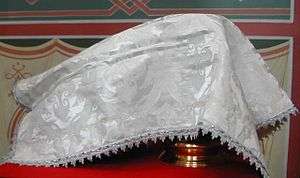
The Bad Touch
"The Bad Touch" is a song recorded by American alternative band Bloodhound Gang. It was released in May 1999 as the lead single from their album Hooray for Boobies, which was released a year later, in the US and UK. The song was remixed by many artists including God Lives Underwater, KMFDM and Eiffel 65.
Like much of the Bloodhound Gang's other music, the song contains a wide variety of sexual colloquialisms. The sleeve for the single features a photo of two zebras in copula.
Lyricism
The main chorus and anthem of the song is the stanza "You and me baby ain't nothin' but mammals; So let's do it like they do on the Discovery Channel", referring to the nature documentaries shown on the Discovery television channel in the 1990s.
The lyrics are composed almost entirely of double entendre, which include a number of references to late-1990s or topical North American popular culture. In the first verse these are: lack of precipitation leading to drought in the United States and specifically the state of Texas; risqué lyrics from musician Prince; Gene Siskel and Roger Ebert from television film-review programme At the Movies giving "two thumbs up"; restaurant-chain Waffle House and their hash browns foodstuffs; the delivery speed of courier firm FedEx; the stock-price of The Coca-Cola Company; and daylight saving time change during the Northern-hemisphere spring-time and its relation to nocturnal penile tumescence.

Aër
The Aër (Greek: Ἀήρ, lit. the "air"; modern Greek: Αέρας; Slavonic: Воздýхъ, Vozdúkh) is the largest and outermost of the veils covering the Chalice and Diskos (paten) in the Eastern Orthodox Church and the Eastern Catholic Churches which follow the Byzantine Rite. It is rectangular in shape and corresponds to the veil used to cover the chalice and paten in the Latin Rite, but is larger. It is often made of the same material and color as the vestments of the officiating priest, and often has a fringe going all the way around its edge. Tassels may also be sewn at each of the corners.
It takes its name either from the lightness of the material of which it is made, or from the fact that during the Nicene Creed in the Divine Liturgy, the priest holds it high in the air and waves it slowly over the Chalice and Diskos. Its original use was to cover the Chalice and prevent anything from falling into it before the consecration. It symbolizes the swaddling clothes with which Christ was wrapped at his Nativity, and also the grave clothes in which he was wrapped at his burial (both themes are found in the text of the Liturgy of Preparation).

Ağrı
Ağrı, formerly known as Karaköse (Kurdish: Qerekose) from the early Turkish republican period until 1946, and before that as Karakilisa (also rendered as Karakilise) (Ottoman: قرهکلیسا), is the capital of Ağrı Province at the eastern end of Turkey, near the border with Iran.
History
In the Ottoman Empire era the area was called Şorbulak. The current town centre was founded around 1860 by a group of Armenian merchants from Bitlis with the name Karakilise ("the black church") that became known to the local population as Karakise and this version was turned officially to Karaköse at the beginning of the Republican era. This name was changed to Ağrı by 1946.
In the medieval period, the district's administrative centre was located at Alashkert, once an important town. The "kara kilise" that gave the town its name was a medieval Armenian church. In 1895 Lynch stayed in Karakilise and wrote that it had between 1500-2000 inhabitants, was nearly two-thirds Armenian, and that a barracks for a locally-recruited Kurdish Hamidiyeh regiment had been recently located in the town.
Çağrı
Çağrı is a unisex Turkish given name. In Turkish, "Çağrı" means "The Call", "Appellation", and/or "Distinction". It also means "Falcon". Notable people with the name include:
Given name
Surname
Podcasts:

